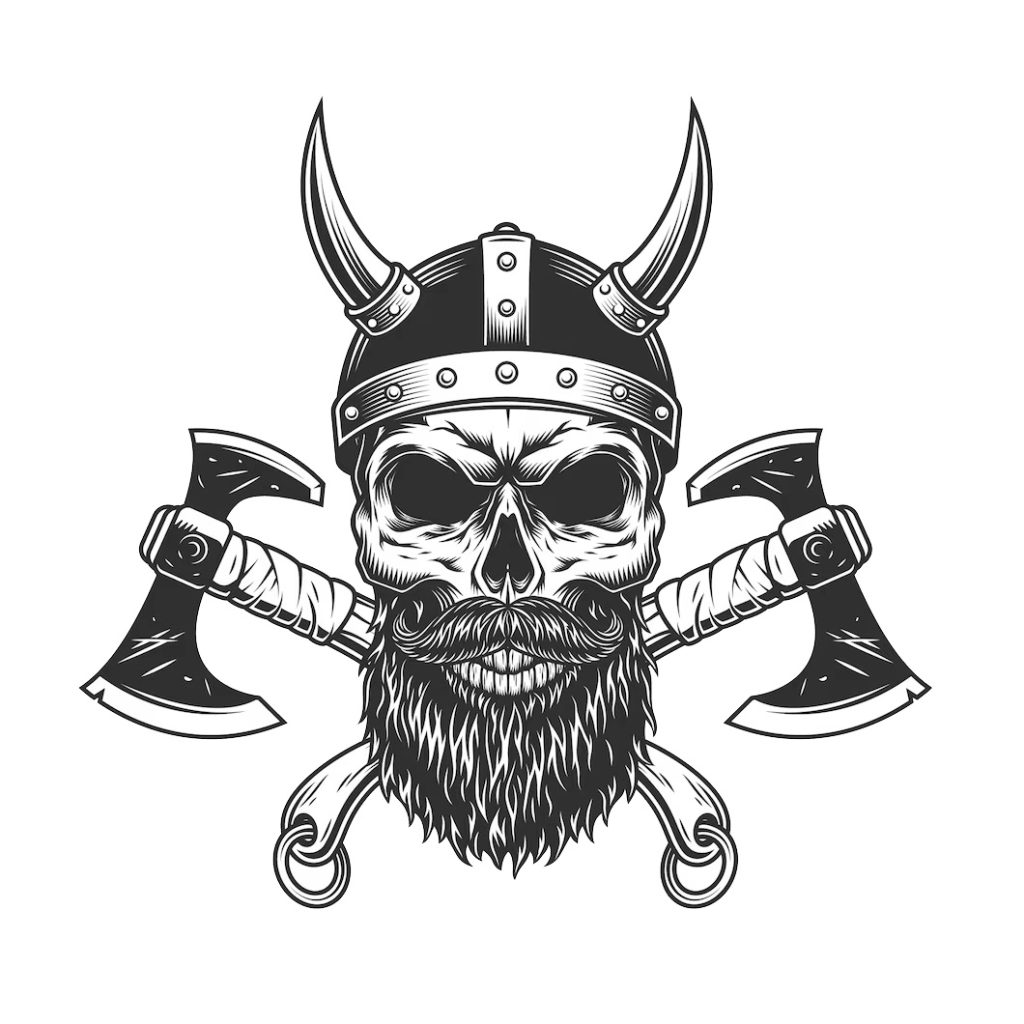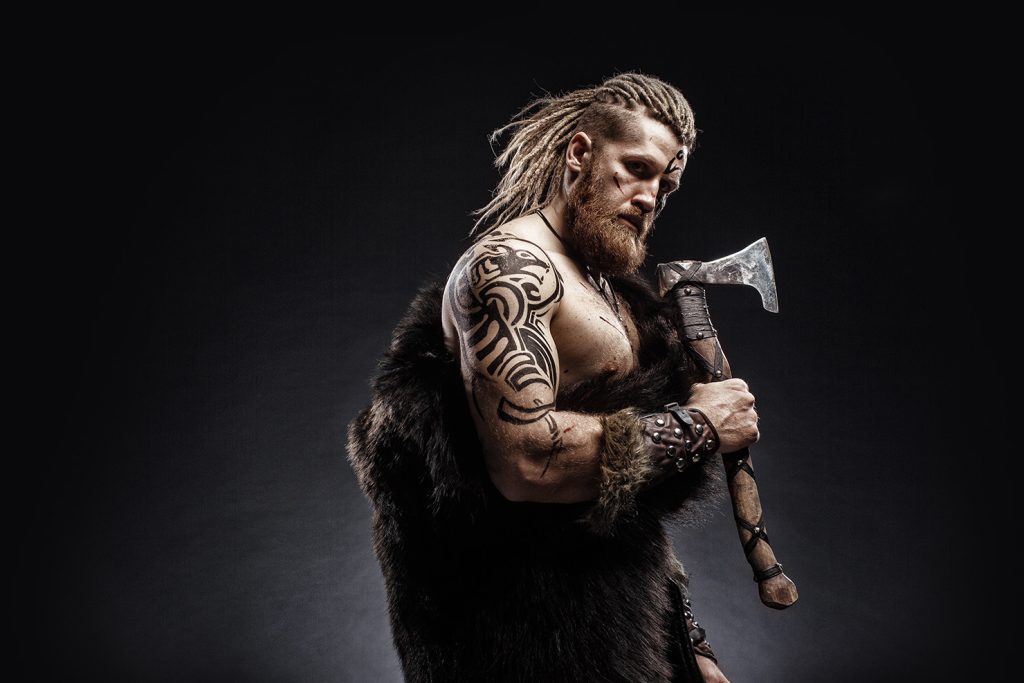
The history of Viking axes is closely intertwined with Viking culture and warfare. Axes were a primary weapon for Viking warriors and played a significant role in their raids, battles, and daily life.
Primary Weapon
Viking axes were versatile tools that could serve multiple purposes. They were commonly used for cutting wood, hunting, and other daily tasks. However, in combat, the Viking axe became a fearsome weapon known for its effectiveness and brutality.
The Hand Axe

The hand axe was one of the primary types of Viking axes used during the Viking Age. It was a versatile weapon that could be wielded with one hand, allowing for quick strikes and maneuverability in combat.
The hand axe typically had a shorter handle compared to other Viking axes, making it well-suited for close-quarters combat. The handle, known as the haft, was usually made of wood and featured a secure grip for the warrior’s hand. It provided stability and control during combat.
The head of the hand axe was made of iron or steel and had a blade on one side for cutting and slashing. The cutting edge could be broad and curved, similar to a traditional axe shape, or more elongated and narrow for improved thrusting capabilities. Some hand axes featured a slightly hooked or bearded shape, which allowed for better hooking and pulling actions in combat.
Viking warriors wielded hand axes with agility and speed, often incorporating shield techniques into their fighting style. The combination of the hand axe and shield allowed for a balanced offense and defense, with the shield providing protection while the axe delivered powerful strikes.
Hand axes were effective weapons against both armored opponents and unarmored foes. The weight and balance of the axe head allowed for swift, accurate swings that could cause significant damage. The cutting edge could cleave through armor or deliver devastating blows to an unprotected target.
Outside of combat, hand axes were also practical tools for Vikings. They were used for woodworking, chopping firewood, and various other daily tasks. Vikings relied on their axes for survival, both in warfare and in their everyday lives.
The design of hand axes varied among different Viking regions and over time, reflecting the preferences and cultural influences of the Vikings. Some axes were plain and utilitarian, while others featured intricate engravings or decorative elements that showcased the warrior’s status or personal symbols.
The hand axe was a vital weapon during the Viking Age, embodying the strength, skill, and resourcefulness of Viking warriors. Today, hand axes serve as symbols of the Vikings’ martial prowess and are often depicted in historical reenactments, artwork, and popular culture.
The Dane axe
The Dane axe, also known as the Danish axe or Viking great axe, was a formidable weapon wielded by Viking warriors during the Viking Age. It was a two-handed axe characterized by its long handle and large, heavy iron or steel head.
The Dane axe had a handle that measured around five feet in length, allowing for greater reach and leverage in combat. The longer handle provided the warrior with the ability to deliver powerful strikes and maintain distance from their opponents. It required the use of both hands, providing stability and control during battle.
The head of the Dane axe was its defining feature. It had a large, wide cutting edge, often curved or convex, that could cause devastating injuries. The size and weight of the axe head gave it tremendous striking power, capable of cleaving through armor, shields, and limbs with ease.
The versatility of the Dane axe made it effective against both infantry and cavalry. The broad cutting edge allowed for sweeping strikes that could engage multiple opponents or dismount horse-mounted adversaries. The opposite side of the axe head sometimes featured a spike or a hook, providing additional options for thrusting attacks or grappling with the enemy.
Viking warriors skilled in wielding the Dane axe could deliver devastating blows while maintaining agility and mobility on the battlefield. They used footwork and body movements to generate power and momentum, enabling them to unleash lethal strikes.
The Dane axe was not just a weapon of war; it also had symbolic and cultural significance. It was often associated with elite warriors and leaders within Viking society. The axe’s appearance, including the shape and ornamentation, could reflect the warrior’s status, wealth, or clan affiliation.
As the Viking Age progressed, variations of the Dane axe emerged. Some versions featured longer handles, allowing for even greater striking range, while others incorporated reinforced axe heads with metal reinforcements or thicker blades.
With the end of the Viking Age, the use of the Dane axe in warfare diminished. However, its legacy as an iconic Viking weapon remains. The Dane axe continues to capture the imagination and is often depicted in historical reenactments, artwork, and popular culture, symbolizing the fierce and formidable reputation of the Viking warrior.

Intricate designs
Viking axes were often adorned with intricate designs, reflecting the warrior’s status, wealth, or personal preferences. The shape of the axe head could vary, with some featuring a broad and curved cutting edge, while others had a more elongated and narrow profile for thrusting attacks.
Intricate Viking designs were a prominent feature of Norse art and craftsmanship during the Viking Age. Vikings excelled in creating intricate and highly detailed patterns and motifs, which adorned various objects and surfaces, including weapons, jewelry, woodwork, textiles, and even buildings. These designs were often characterized by their intricate interlacing patterns, stylized animal motifs, and mythological symbolism.
One of the most recognizable Viking design elements is the interlacing pattern, also known as the “zoomorphic” style. This style featured intricate and symmetrical knotwork, where animal forms and abstract shapes were intricately intertwined. The interlacing patterns symbolized the interconnectedness of nature and the cosmos, as well as representing concepts like eternity and the continuity of life.
Animal motifs were also prevalent in Viking designs. These motifs depicted animals such as dragons, serpents, birds, wolves, horses, and other creatures, often stylized and abstracted. These animals were believed to possess spiritual and protective qualities, and their representations were used to invoke their power and symbolism.
The Viking design repertoire also included depictions of mythological creatures and figures from Norse mythology. For example, the Valknut, a symbol associated with the Norse god Odin, consisting of three interlocking triangles, was commonly found in Viking art. Other mythological figures like the World Serpent Jormungandr, the ravens Huginn and Muninn, and the hammer-wielding god Thor were frequently depicted in Viking designs.
In addition to the interlacing patterns, animal motifs, and mythological symbolism, Viking designs incorporated other elements such as geometric shapes, spirals, runic inscriptions, and abstract forms. These designs were often engraved, carved, or woven into various materials, showcasing the Vikings’ mastery of craftsmanship.
Viking designs were not limited to artistic expression alone but also had practical purposes. Engravings on weapons and armor, for instance, not only added aesthetic value but also served as a means of identification, symbolizing the warrior’s status, clan affiliation, or personal symbols.
Various Battle Techniques
In battle, Viking warriors would employ various techniques with their axes. They would often use their shields in conjunction with their axes, engaging in close combat and shield-bashing tactics to create openings for powerful axe strikes. The weight and balance of Viking axes allowed for swift and devastating attacks, capable of cleaving through armor and causing severe injuries.
Viking axes continued to evolve over time as the Vikings encountered different cultures and technologies. They incorporated improvements in metallurgy, resulting in stronger and more durable axe heads. Some axes even featured a hook or a spike on the opposite side of the cutting edge, providing additional options for grappling or thrusting attacks.
The Viking Age eventually came to an end, and the use of Viking axes in warfare diminished. However, their impact on Viking history and legacy remains significant. Viking axes are iconic symbols of the Viking warrior and their reputation as fierce and skilled fighters. They continue to captivate the imagination and are often depicted in popular culture, showcasing the enduring legacy of the Viking axe.
